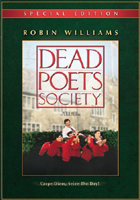 BUY IT AT AMAZON: CLICK
BUY IT AT AMAZON: CLICK
HERE!
STUDIO: Touchstone Home Entertainment
MSRP: $19.98
RATED: PG
RUNNING TIME: 129 Minutes
SPECIAL FEATURES:
• Commentary by Peter Weir, John Seale, Tom Schulman
• "Dead Poets: A Look Back" retrospective
• Raw takes
• "Master of Sound: Alan Splet" featurette
• "Cinematography Master Class" with John Seale
Arguably, no other single movie has created so
many English majors as Dead Poets Society. Its quietly heroic
portrayal of the power of words and the dignity of human interaction has popped
quite a few corks in the idealists among us. Director Peter Weir (Master
and Commander, The Truman Show) pulled off quite a feat, getting his
film appreciated by such a large, sappy subset of the audience (myself
included) — especially since Dead Poets Society isn’t about
idealism; it’s about anarchy.
The Flick
Not that Weir was playing tricks on his public,
of course. There is plenty of legitimate idealism to propel the plot. In the
setting of a rigid boy’s academy, a small group of students are influenced by
their new English teacher, Mr. Keating (Robin Williams), who coaxes them to
"suck the marrow out of life." The students (Ethan Hawke of Gattaca,
Robert Sean Leonard of House, MD, Josh Charles of Sports
Night, and others) present the gamut of caterpillar-to-butterfly
stories, pursuing girls, self-expression, acting, and rebellion, all in the
name of expanding beyond the stiff walls of Welton.
Had that been the extent of the script for the
film, I’d lay good money it still would have found a solid audience. The plot
points are broad and cliché, when isolated: suicide, inter-office politics, and
adolescent fumblings. If wandering through these familiar stories were the
whole of Dead Poets Society, it would have been successful,
thanks to a number of filmic elements beyond the script that Weir wrangled
together. It would have distanced people who hate sentimentality and attracted
those who love it — in other words, not much would have changed. Except that
where other stories about inspirational teachers (Mr. Holland’s Opus,
Mona Lisa Smile) are content to rest on tissue-friendly resolutions,
all the sequences of Dead Poets Society point toward something
deeper: a criticism of public school systems and a celebration of anarchy.
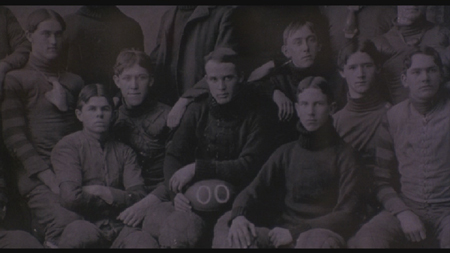
Nutsack jokes are older than you could possibly imagine.
I don’t mean circled-A, high-school clique-style
anarchy — that’s about as much of a true philosophy as you’ll find in The
Matrix. I mean true anarchy, the V For Vendetta brand of
anarchy, the idea that each individual is capable of making decisions for
himself and can not have that right revoked by anyone. That’s certainly
another piece of idealist thought, but it’s a different enough sentiment from
the dramatic plot of the film to deserve its own mention.
It’s early on in the running time that the
audience gets a glimpse of the direction Weir is going. Over dinner, Mr.
Keating and one of his colleagues have a brief conversation about Keating’s
teaching methods (which include ripping handfuls of text from a poetry book),
during which Keating says, paraphrased, "I’m trying to teach them to be
free-thinkers." His colleague replies, also paraphrased, "Fuck that
shit." The cynicism of the established school officers comes into direct
contention with Keating’s idealism — but it isn’t the idealism that we are
told to care about, it is Keating’s relentless pursuit of it, despite the
school’s guidelines, and the way it rubs off on the impressionable young minds.
That sort of free thinking — participating in
the
is exactly what the public school system, at least in
designed to squelch, and it’s precisely what Mr. Keating wants to communicate
to its students. That’s the core message of Dead Poets Society:
not that the love of beautiful things has any sort of noble power, but that great
things can be accomplished, on many scales, by deciding for oneself what is
important.
All right, enough of the abstract. Robin Williams
was nearly a perfect choice for the role of Mr. Keating. He is, as many
comedians are, natural anarchists, predisposed to pointing out the fallacies of
society. The sequences in which he is in full-on stick-it-to-the-man mode work
great, and show a range of conviction and playfulness. Those scenes where he is
required to subdue himself a bit more and have a character beyond that which he
shows in the classroom are flat. He’s got a wide range in one direction, and
almost none in the other, but since more is required of the former than the
latter, it works just fine.

"This is my propaganda tube!"
Weir has always had a good command over the
balance between dramatic and mundane, and it works to good effect here. The
camera work and pacing parallel the needs of the story and work to keep the
sentiment from overpowering the narrative. This is one of the few films that can present
its climax in the closing seconds and not come off as a cop-out, and writer Tom
Schulman (love the irony of his name) deserves a fair bit of credit for that.
The technical merits follow the basic tenet of classical
film editing: to be so deliberate as to be invisible unless you’re watching for
them. As such, the plot is allowed to unfold just as deliberately, and the
audience gets an unfettered experience.
Dead Poets Society is a
celebration of one of the qualities that continues to attract humanity to art:
it needn’t abide by the rules. Though the mix between moral and sentiment is
dangerous, and maybe too potent for a fair number of viewers, the film gets
pretty darn close to being art itself.
7.8
out of 10
The Look
1.85:1 widescreen. Cinematographer John Seale did
a fine job pulling out the color tones of a limited environment; the school is full
of rich browns and cold grays, and the countryside gets frequent reference as
it changes from bright fall colors through to the dreary winter monochrome. The
transfer work, as with most anything done on film in the 80s, has a few
problems dealing with grain, but overall (and from a decent distance back from
your set) it’s of good quality.
8 out
of 10
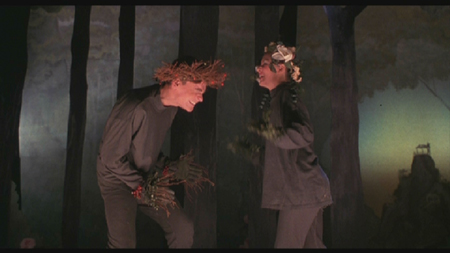
"Oh, the stigmata!"
The Noise
Dolby digital 5.1
surround. One of the featurettes on the disc is devoted to sound designer Alan
Splet, and serves to highlight the beautiful job he did on the film. There’s
nothing in the way of overt or flashy sound design, but the ambient effects go
a long way toward establishing Welton as a physical place for the audience. The
surround mix supports the design almost perfectly, spreading out the effects
between the front and rear channels to put the viewer in the middle of the
school and its idyllic surroundings.
The music, by Maurice
Jarre, is delicate and serves the scenes well. It only has one memorable theme,
but it is a great one — and one that was partially lifted for "It Feels
Like Christmas" in The Muppet
Christmas Carol.
8.5 out of 10
The Goodies
This double-dip was a
long time coming, and though the bonuses are few in number, they’re nearly all
worth the wait.
Peter Weir,
cinematographer John Seale, and writer Tom Schulman provide a feature-length
commentary. Weir dominates most of the conversation, and is a pleasure to
listen to. He is very deliberate in his choice of words — a quality that
admirably mirrors the tone of the film — and gives off an air of humility as
he praises and tells stories about the people who added their touches to the
finished product. Schulman and Seale also reel off a few good anecdotes and
offer some insight into their particular jobs. All three are articulate, for
which I’m grateful. Oddly enough, screenwriters tend to be the most
inarticulate on commentary tracks, but Schulman knows what he’s talking about.
There are two focused
featurettes: one on the sound design and its designer, Alan Splet, and one on
the cinematography of John Seale. The sound design featurette is based around
interviews with Peter Weir and with another director who worked with Splet, David
Lynch. Both directors have nothing but respect for Splet, and, though the
bonus is more about the man than about his work, it still gives a little
insight into the process of sound design that is often overlooked.
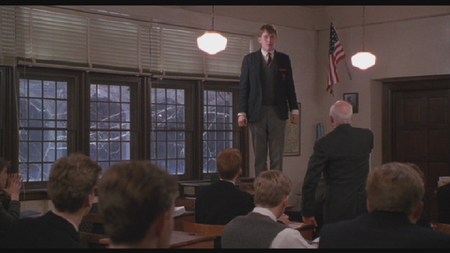
He can see all the way to Ash Wednesday, poor bastard.
The cinematography
feature is worth the price of the disc almost on its own. John Seale takes a
detailed look at the lighting of a set, which is another bit of the esoterica
of filmmaking that gets lost by the audience. There is so much work involved in
getting the right balance on the set and on the actors that it’s almost like
watching a lion tamer working with his beasts: there are too many dependent
variables, and change can come too quickly.
The remaining two
bonuses tend more toward filler. There’s a retrospective documentary, featuring
interviews with all the principals and their memories of production. The last
bonus is a set of raw takes, which serve to highlight the importance of all the
post-production work.
9 out of 10
The Artwork
I hate the green-to-black gradient behind the
title picture. It makes the case look like a Christmas special. The
Miracle at Welton Academy. I like the picture that has long featured on
the marketing for this film, though. Not only does it appeal to the sentimental
— the hoisting up in admiration of a man who has touched lives — but it
relates to an overlooked sequence of the film in which Mr Keating declares his
love of sport because it is one of the only times in which we allow other
humans to push us to excel.
Oh, and the tag line? Yeah, it’s a movie about an English teacher, but they put a comma splice on the cover.
6 out of 10
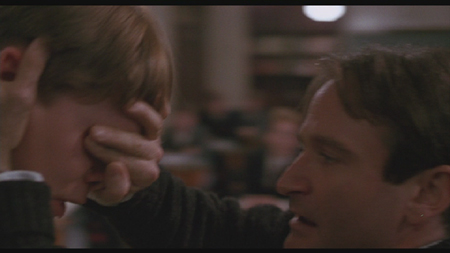
I never can remember what a stud in the left ear means.
Overall: 8 out of 10